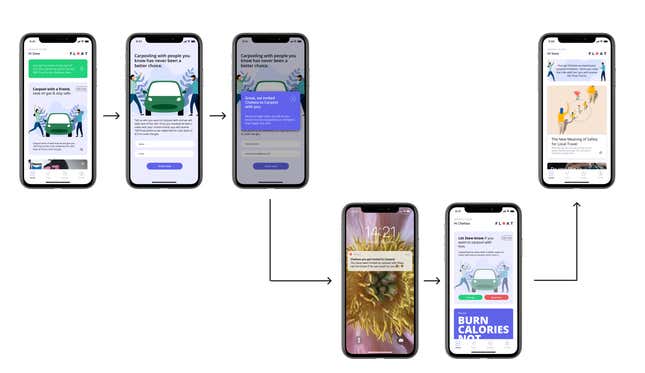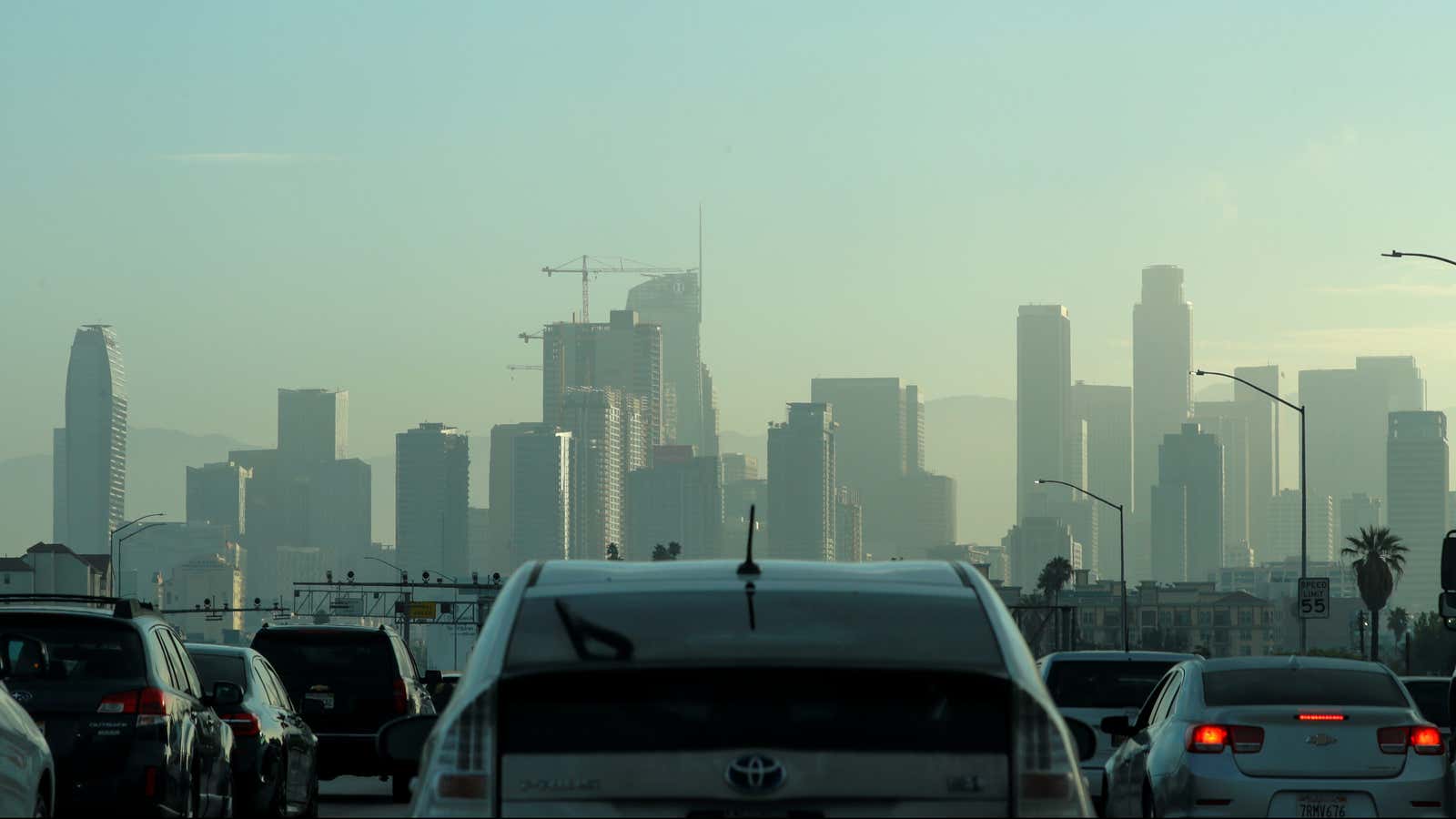“It beats driving alone,” a cartoon skunk declares in a cheerful 1974 public service announcement encouraging Americans to carpool. In the ad, a reporter interviews Noah (captain of the Biblical ark) about the rewards of sharing a ride. “It worked out for us,” the bearded sailor chirps. “You’re going to have more fun together,” his animals croon.
Fun wasn’t the real purpose of doubling up for drives in the 1970s. With the US facing an energy crisis at the time, carpooling became an expression of patriotism, just as it had been during World War II. In the ensuing years, cities began creating carpool lanes on highways in an effort to cut carbon emissions and ease gridlock, with mixed results. As carpooling fell out of fashion, driving alone became the norm.
Now, thanks to Covid-19, the custom appears poised to make at least a modest comeback, according to three transportation companies that spoke to Quartz.
This is not carpooling through a ride-sharing app. Uber, Lyft and other on-demand companies have temporarily suspended their carpool options for safety reasons. (“Slugging,” an informal system for sharing rides with strangers in Washington, D.C, is also discouraged during the pandemic.) Instead, people are reportedly turning to old-fashioned, community-based carpooling, with coworkers, neighbors, and fellow parents.
While the public awaits reliable data about the safety of public transportation, the fear of contracting Covid-19 on buses and subways has already pushed driving and car ownership to new levels. Some people are now choosing to carpool as a way to reduce travel costs, be neighborly to someone without a car, and—perhaps—help reduce traffic on congested streets, says Stew Langille, founder of the Float app, which allows people to plan commutes and collect rewards.
Carpooling this way beats riding with strangers, he says, because people are more likely to trust neighbors or friends to stay home if they’re sick, and to be honest about how stringently they’re following Covid-19 guidelines.

Langille noticed an uptick in shared drives among friends when Covid-19 led to lockdowns in Singapore, where Float was launched before its recent US debut. In response, the company quickly crafted a “Carpool with a Friend” feature which has since been rolled out in the San Francisco Bay area, and will soon arrive in New York.
The feature gives people a $10 rebate for gas as a way to encourage folks to go green and share a ride, and to help Float attract new customers. (Separately, it’s also trying to gauge how interested people would be in sharing a car through fractional ownership, an entirely new model for the car industry, Langille says.)
Float still has a tiny user base in the US, but it has seen a more than 400% increase per month in people choosing the Carpool with a Friend option. (That’s still only about 1,000 monthly users.) “As people come out of the bubble, we’re seeing more and more people want to carpool with friends, with somebody they know,” Langille says, “We think it’s going to be a really big part of what we’re going to be doing into the fall.”
At Waze, the navigation app owned by Google and used by 130 million people globally every month, Dani Simons, head of public sector partnerships, says that she’s also expecting a major rebound in carpool usage once more schools and businesses begin opening around the country through the fall. People are looking for control and trust, she says, and carpooling can offer both.
Waze’s carpooling feature launched in 2018 in the US, and has since attracted more than 800,000 rides monthly. The app is not designed strictly for people who already know each other, but users can create groups with their colleagues, neighbors, and friends who have a similar appetite for risk. Because passengers reimburse drivers for some of the gas costs, this option is “also helping people who maybe can’t afford to drive every day and maybe don’t want to drive alone every day,” she reports.
In a recent study conducted by the Yale Center for Customer Insights, sponsored by Waze, respondents actually said they would be less likely to carpool when they needed to go back to work than they were before the pandemic. However, more people ranked their likeliness to carpool higher than their chances of ride-sharing on Uber or taking a bus.
In Brazil and Mexico, Waze has already seen an increase in carpooling, compared to the US, which is still in the earliest days of workplace re-openings. Simons attributes the difference to shelter-in-place orders that were less severe in Brazil and Mexico, where more Waze Carpool users are likely to have jobs that cannot be done from home.
Ridership on Waze Carpool was on track to cross over a million monthly users when the coronavirus’s spread brought traveling of any type to a standstill in March. The app’s pre-Covid popularity, however, was eye-opening to Simons, who was among the original group to launch Citi Bike, a bike-sharing program in New York City, in a former job.
Bike-sharing may be a great last-mile solution for city dwellers, she says, but most Americans have much longer commutes. Carpooling is one way to address “the growing mismatch between where people live and where their jobs are,” she says, and that distance is greatest, on average, for people who are black, brown, or poor.
“It’s flexible, it’s distributed, and it’s not like you have to live on one line to carpool,” Simons says.
Finally, Enterprise, the car rental company, told Quartz that its Commute with Enterprise vanpool service has been in high demand “among coworkers in a variety of essential services sectors, including manufacturing, distribution, construction and healthcare” through the pandemic.
People who have a similar shifts usually vanpool together, according to an Enterprise spokesperson, and the daily ride “provides the opportunity for colleagues to get to know one another better, while saving money and time in their day.” Employers typically line up the van service, and the staff who take advantage of it split the costs and typically rotate the driving responsibilities.
How safe is carpooling?
So just how safe is it to carpool with familiar faces? In this pandemic, there are no easy answers.
“We have to think in terms of degrees of risk rather than a purely safe/unsafe classification,” Jessica Justman, senior technical director at ICAP and associate professor of medicine in epidemiology at Columbia University’s Mailman School of Public Health, tells Quartz in an email. “We already do this kind of risk assessment with other decisions we make all the time. In fact, just getting into a vehicle in the first place entails the risk of being in an accident.”
Before arranging a carpool, she suggests weighing three key considerations: “the necessity/importance of carpooling as the way to get to work, the risk of contracting severe COVID, and who is in the carpooler’s social network and their risk of severe COVID-19.”
Your calculations should also include “the duration of the ride, how well the passenger and driver know each other and know each other’s habits in terms of adherence to mask wearing, social distancing, and recent travel to hot-spot locations,” she says. “Opening the window at least a few inches will help promote more air circulation and reduce risk, but that may be hard to do for long rides on a highway and in cold weather.”
Companies and websites that encourage carpooling safely recommend the following precautions, drawing on guidelines from the Centers for Disease Control and Prevention and other health officials.
- Limit your carpool to two people, including the driver. The passenger should in the back, as far away from the driver as possible.
- Stay home if you’re experiencing any symptoms of Covid-19.
- Wear masks.
- Open the windows to keep the air circulating and disperse any potentially virus-loaded aerosols.
- Agree on the rules for carpooling and social distancing before you meet.
- Clean and disinfect the high-touch areas of the car after driving.
- Use hand sanitizer after touching door handles and other high-touch zones. Then wash your hands for 20 seconds (using regular soap is fine) when you arrive at your destination.
To this list, new research into how talking or singing may be spreading Covid-19-infected aerosols would also suggest keeping chit-chat to a minimum—and, much to James Corden’s disappointment, skipping the carpool karaoke.
